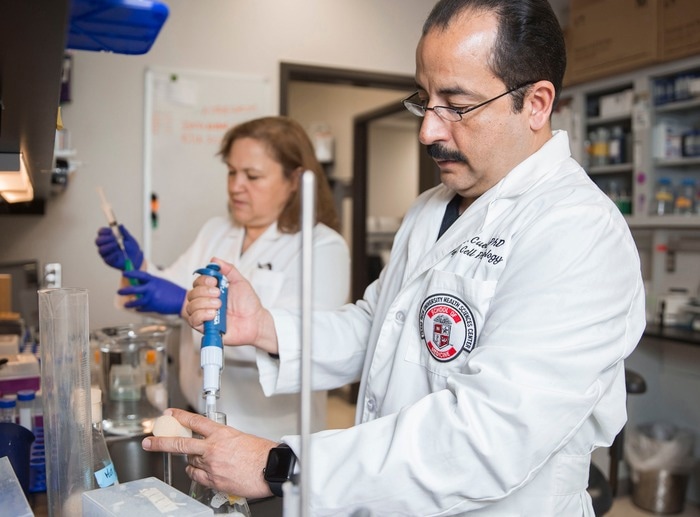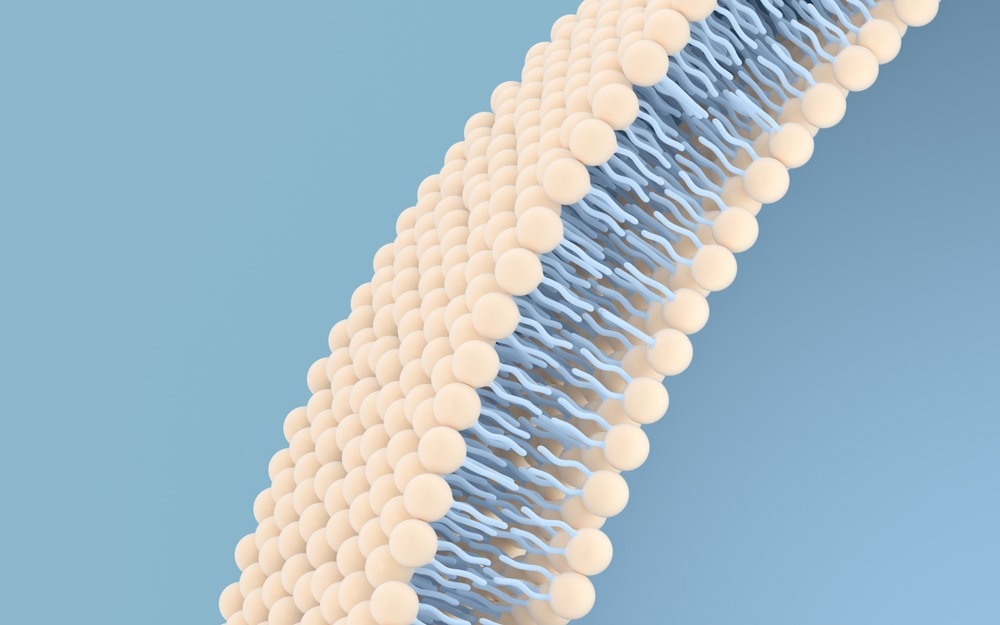Reviewed by Danielle Ellis, B.Sc.May 19 2023
Each living cell has small, highly specialized conduits called potassium (K+) channels, which are responsible for the highly selective and fast transfer of K+ ions across cell membranes.
 TTUHSC’s Luis Cuello, Ph.D., (right) recently was awarded an R35 NIH grant to apply his novel method for studying human potassium channels he can now express in bacteria to target diseases such as epilepsy, arrhythmia, diabetes, and others. Image Credit: Texas Tech University Health Sciences Center.
TTUHSC’s Luis Cuello, Ph.D., (right) recently was awarded an R35 NIH grant to apply his novel method for studying human potassium channels he can now express in bacteria to target diseases such as epilepsy, arrhythmia, diabetes, and others. Image Credit: Texas Tech University Health Sciences Center.
Each living cell’s correct functional behavior is defined by the specific transport system used by K+ ions. As a result, the K+ transport mechanism effectively controls a wide range of extremely complicated functions, including the normal electrical activity of brain neurons and the rhythmic beating of the human heart.
Luis Cuello, PhD, is a Professor in the Department of Cell Physiology and Molecular Biophysics at Texas Tech University Health Sciences Center (TTUHSC) School of Medicine. Cuello has recently received a five-year R35 MIRA (Maximizing Investigators’ Research Award) grant from the National Institutes of Health (NIH) to continue his study.
MIRA funding does not support a specific research initiative. Instead, they enable an investigator to create a plan where their study will be in 10 to 15 years, as well as a model outlining a recommended framework for reaching that goal.
Cuello’s path to this new NIH grant began in 2014, during a structural biology revolution (the study of how biological molecules are built). This revolution was centered on the application of a new technology known as cryo-electron microscopy, or cryo-EM. Though it marked a significant advancement in understanding the structure of biological molecules, the equipment required to perform cryo-EM is expensive.

Image Credit: Vink Fan/Shutterstock.com
Despite the cost, Cuello noted that many colleges and universities got into the technology, mostly for the chance to solve protein structures: how they look, work, and move.
I am a structural biologist, but at the moment, we are a small institution, and to buy equipment like that involves a serious amount of money. At that time—it was 2015 or 2016—I had to reinvent myself because I couldn’t just sit there and wait and hope for the new toy to be able to do my job; I cannot do that. So, we started to study the function of potassium channels from a thermodynamic point of view.”
Luis Cuello, Professor, Department of Cell Physiology and Molecular Biophysics, Texas Tech University Health Sciences Center
Cuello’s lab began to look into the thermodynamics behind potassium channel ion selectivity and penetration. They used isothermal titration calorimetry to evaluate the binding of ligands, ions, and drugs to potassium ion channels, which is Cuello’s area of expertise.
Cuello continued his research for several years with the help of his department, which included the acquisition of two machines to execute his thermodynamic technique. As he advanced, mainstream technology shifted to expressing human ion channels in human cells, a procedure Cuello found less than optimal.
The human cells grow very slow, they require very expensive grow media and it's a time-consuming approach. You really have to be babysitting those cells, and they can get contaminated very easy, so there are many drawbacks about using that system.”
Luis Cuello, Professor, Department of Cell Physiology and Molecular Biophysics, Texas Tech University Health Sciences Center
Rather than continuing his thermodynamic method or employing human cells, Cuello began experimenting with the overexpression of human ion channels, specifically potassium channels, in bacteria. He stated that researchers have sought for years to employ bacteria since they are less expensive, more flexible, grow faster, and are easier to purify. Bacteria may also be generated in large quantities, which is useful in biophysical research.
After many attempts—we have been going for almost 10 years—we finally cracked the code and we developed a methodology that is allowing us to express very large quantities of human potassium channels in bacteria. We’ve shown that we can purify them and that we can produce them in large quantities. And when we purify them, they retain their biological function, which opens the door for us to do many, many biophysical studies.”
Luis Cuello, Professor, Department of Cell Physiology and Molecular Biophysics, Texas Tech University Health Sciences Center
Cuello applied for an NIH MIRA grant using his newly created approach, proposing to use his technology to target numerous human potassium channels that he can currently express in bacteria. The channels he will target under the grant are related to diseases like arrhythmia, epilepsy, diabetes, and others.
“By developing this technology, I’m purifying for this grant those channels that are important for the nervous system or for the heart,” Cuello stated.
Cuello’s grant also comprises funds for the purchase of two major pieces of equipment that will be used in that research. He stated that the machines will bring cutting-edge technology to TTUHSC and that the machines supplied by his grant will also be available to other department partners conducting their own research. One of the machines will be important to measure the thermodynamics of ion binding in human potassium channels, which has never been done before.
“These are very competitive grants because you have to compete with established investigators nationwide. You have to be highly productive and you have to show why what you are doing is so important,” Cuello stresses.
Cuello said he was reminded of the importance of his lab’s study at a recent Biophysical Society meeting when he ran into his NIH grant officer. Cuello’s application for the grant had been recommended by the officer.
Cuello concludes, “He told me that the NIH are very impressed because our institution, compared to larger institutions, is doing this kind of work. In my humble opinion, all of us at TTUHSC should be happy and proud that the NIH recognizes the work that we have been doing here. It is recognition of the research that the underdog is doing here in rural Texas. We are doing things at TTUHSC that are important, and it is rewarding to see that recognition happen.”